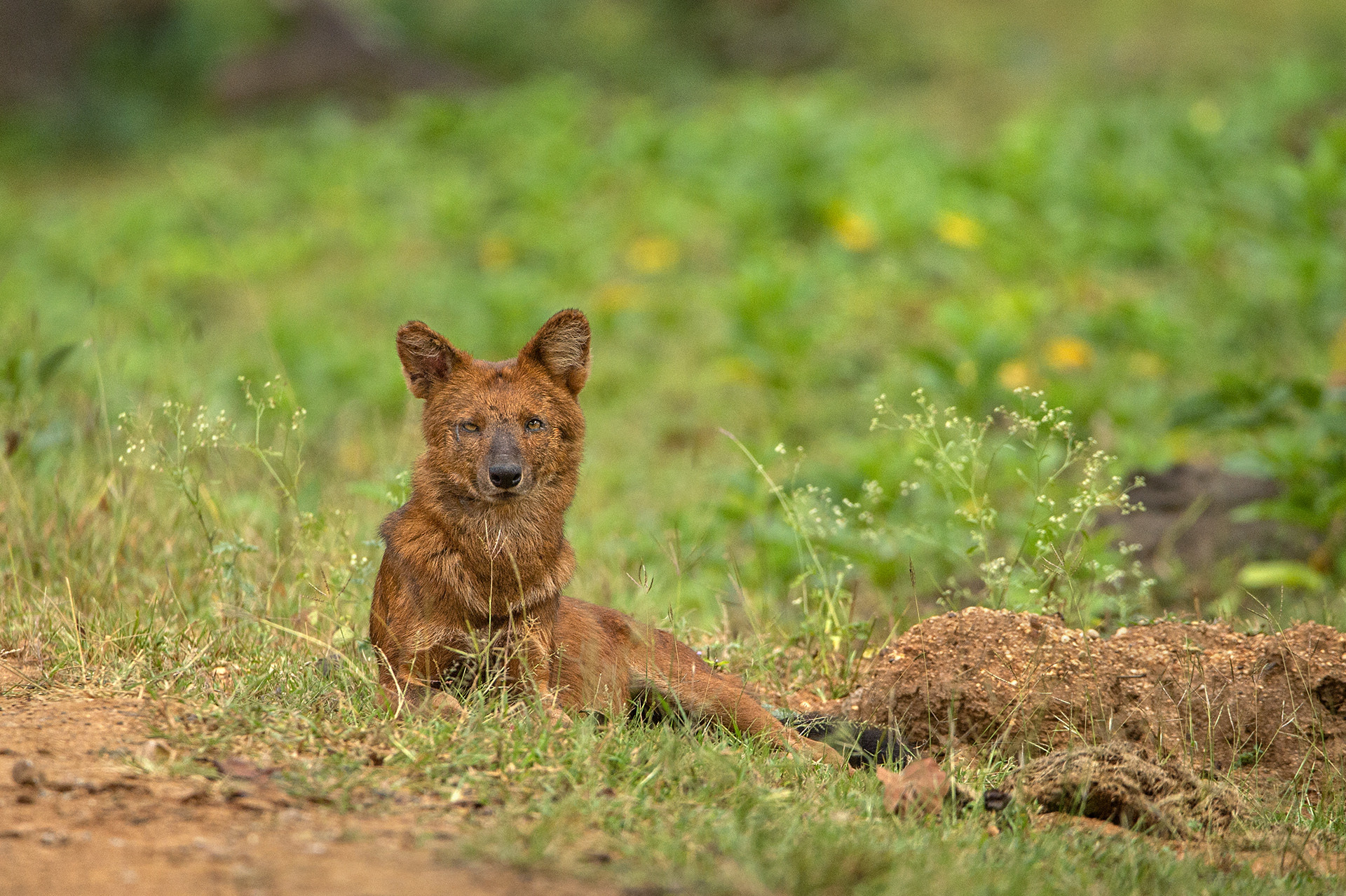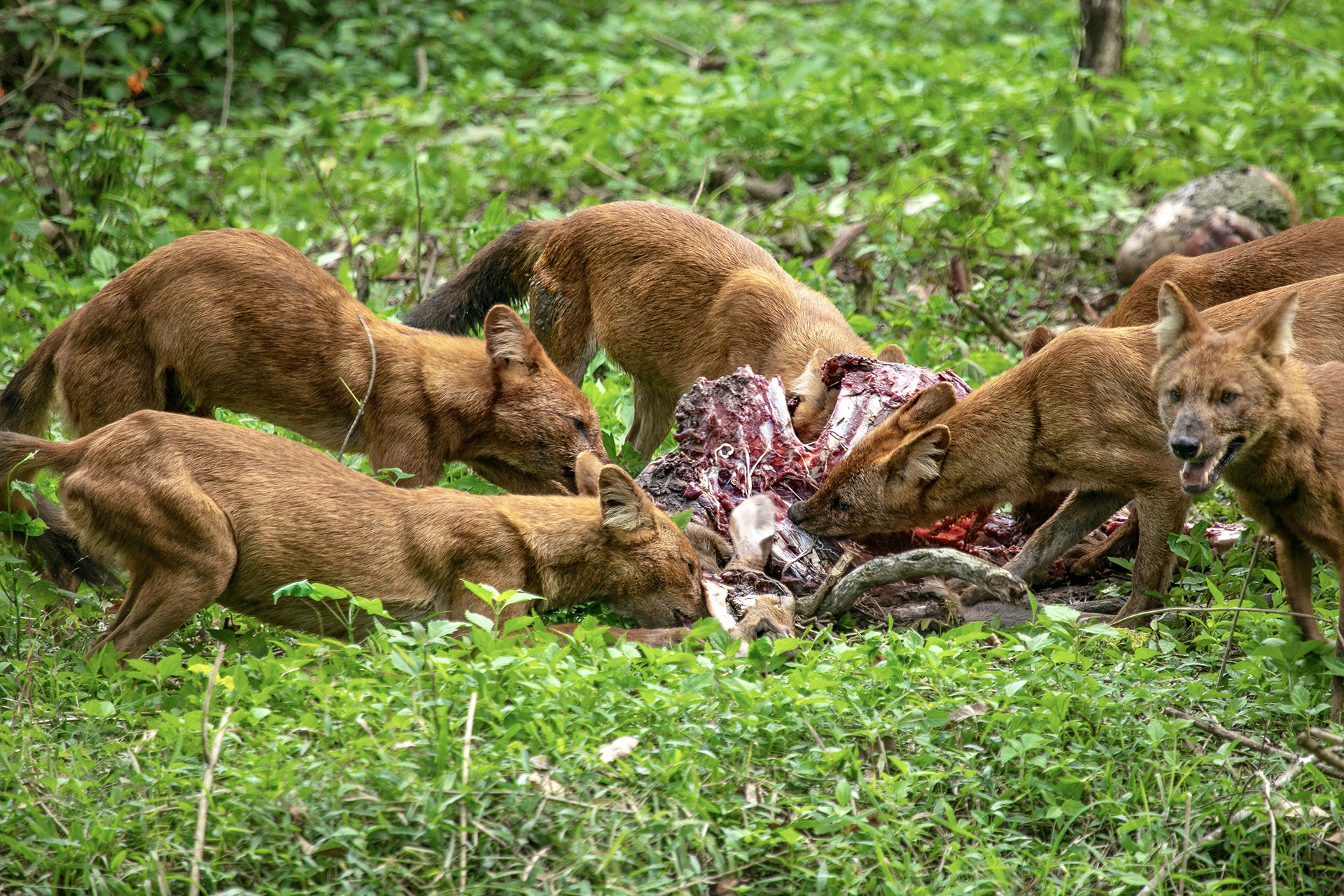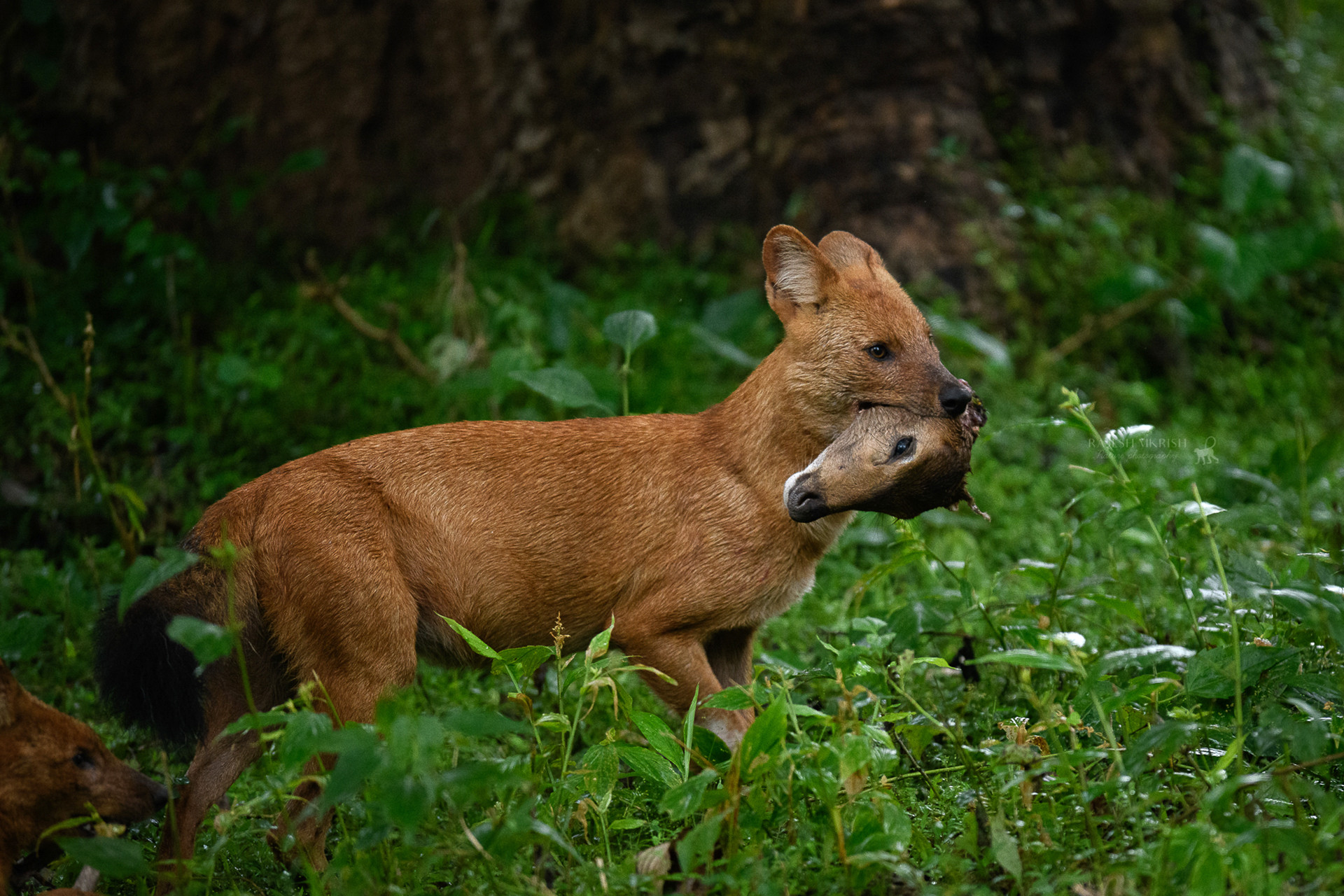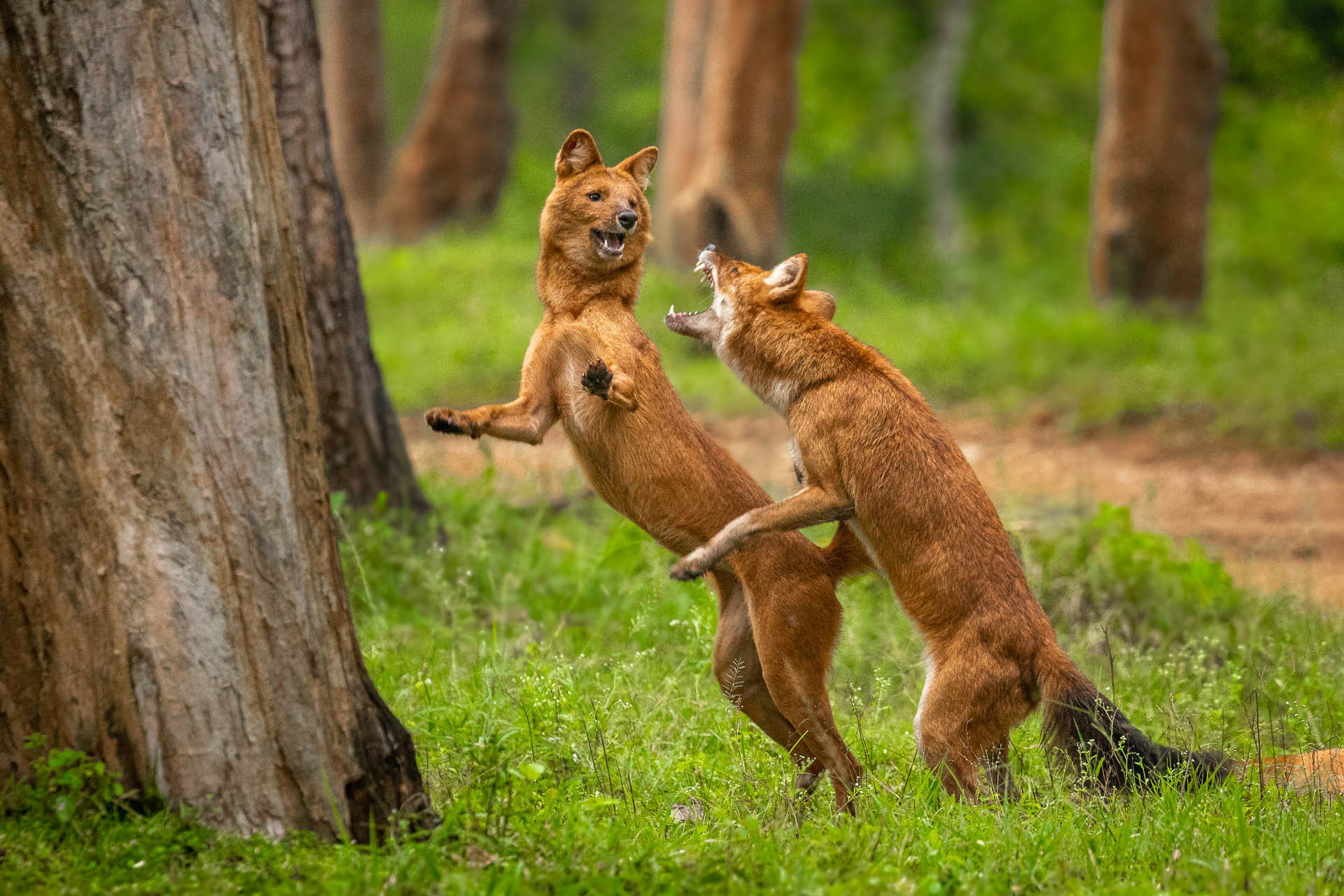1 – What's in a Name?
The Dhole or the Asiatic Wild Dog is a formidable predator of the Indian jungle. Those of us who have seen this fantastic beast in the wild and are familiar with its habits can vouch for the strong emotion that it evokes. But how did the Dhole get its name? It is not fully clear. Its Latin name Cuon alpinus loosely translates to the "dog-like animal from the mountains." Although commonly referred to as a "wild dog," the Dhole is not a true dog. Its closest relatives are the painted dogs of Africa and the bush dogs of South America. The word 'Dhole' itself may be a misnomer derived from thola, the Kannada word for wolf.
2 – Packing a Punch
Dholes live in social units called packs. And this social construct is extremely important for them. Typically, packs have 6-8 individuals. But these numbers can vary drastically depending on location, season, prey numbers and intensity of competition with other large carnivores like the tiger. Current knowledge hints at packs generally comprising an alpha male and female which are at the top of the pecking order. These two individuals mate and reproduce, while the other members of the pack (most of them related to either of the alphas) partake in hunting, defending their territory and raising the alpha pair's pups.
3 – Every Dog Has its Prey
Dholes are hypercarnivores - most of their diet includes the meat of other animals. They are extremely efficient hunters and are capable of catching, incapacitating and eating up prey animals that are more than ten times their size. Individual Dholes and smaller packs hunt down small animals like hares or Mouse Deer. Medium to large-sized packs often hunt deer like the Sambar and Chital, and occasionally, even the massive Gaur. Dhole diet also varies based on location. While the Sambar Deer is the most common prey species on their menu, Dholes in central India tend to eat a lot more primates, while those in northeast India consume more domestic livestock compared to other parts of the country.
4 – The Woods are Lovely, Dark and Deep
Carnivores that live in social groups are usually adapted to thrive in relatively open habitats like savannah grasslands, open scrub, or woodlands with sparse vegetation. But the Dhole is peculiar in that it requires forest habitats across most of its range. Dholes are extremely habitat-sensitive and forest-dependent. They seldom survive if forest habitats are degraded or cleared. In India, almost all Dhole populations are therefore found in the forests of Western and Eastern Ghats, central India and northeast India.
5 – Who Let the Dogs Out?
Unfortunately, most Dhole populations are now restricted to Protected Areas like national parks and wildlife sanctuaries. But this does not mean that they do not occur in other locations outside our parks. Across their range in India, smaller populations continue to live in fragmented, unprotected forests and agroforests like coffee and tea plantations. Individuals dispersing from Protected Areas may be using these secondary habitats' to move from one location to the other. Unprotected forests and agroforests are therefore very important for maintaining connectivity between Dhole populations.
6 – Friends w/wo Benefits
The dog may be man's best friend, but the dhole has a twisted relationship with humans. Literary accounts such as Rudyard Kipling's Jungle Book paint a gory, vile image of the animal. But in modern times, many people are either unaware of its existence, are indifferent to it, or view it with measured disdain for somewhat justifiable reasons. In southern and central India, Dholes have a neutral relationship with people, usually avoiding areas with human activity. But in northeast India, Dholes are more frequently involved in killing domestic animals and are therefore despised. Nonetheless, Dholes play a crucial role in maintaining the balance of forest ecosystems, making their existence beneficial to us in the long run.
7 – A Cat-eat-dog World
Dholes share space with tigers and leopards across large parts of their range in India. Much like cats and dogs in our neighbourhoods, these wild cats and wild dogs do not always get along. They chase each other away from kills; tigers kill and sometimes eat dholes, and dholes harass and chase leopards up trees. How then have they managed to coexist in the same spaces for so long? Recent research shows that they try to avoid each other as best as they can, by consuming slightly different prey animals, and being active in locations and time periods such that they don't frequently run into each other. All they need is well-protected forests and sufficient prey animals. Perhaps we should all take a leaf out of their book and learn a thing or two about coexistence!
8 – Clear and Present [EN]Danger
The International Union for Conservation of Nature (IUCN) classifies the Dhole as an Endangered species. In other words, India's wild dogs are not faring all that well. While we do not have exact population counts, experts believe there may be 4000-10,000 Dholes left in the wild, with only 1000-2000 adult individuals capable of reproducing (alphas). Although Dholes are found across 11 countries, with places like India, Bhutan and Thailand being hotspots, none of the range-countries have dedicated conservation initiatives targeted or tailor-made to save the Dhole.
9 – Mutt Ado About Nothing
One would think that a fascinating animal like the Dhole would have piqued the interest of many natural historians, biologists and conservationists. But this, unfortunately, is not the case. Over the past 145 years, less than 300 studies have focused on the Dhole, and nearly half of them have been in the past decade alone. Much of our understanding of their behaviour comes from the seminal work of Dr AJT Johnsingh in the 1970s and 80s. If young wildlife biologists are looking for a species to latch onto, the Dhole surely provides a fine opportunity!
10 – Penny Wise, Hound Foolish
India has made great strides in its conservation efforts. Considerable money and resources are spent on species like the tiger and the elephant, and these endeavours have shown certain success in recent times. Although the species has disappeared from nearly 60 per cent of its range in the past 100 years, the country still has the highest number of Dholes in the world. Yet, this underdog of India's tropical forests continues to wait in the wings, anticipating a chance to shine in the limelight. Here's hoping the next decade brings greater scientific focus, public support and conservation efforts to better understand and protect India's amazing wild dogs.









